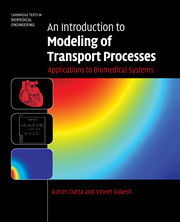Book contents
10 - Solving the equations: numerical methods
from III - Background theory
Published online by Cambridge University Press: 05 June 2012
Summary
In the spirit of using the software less as a blackbox, it is essential to have at least a rudimentary knowledge of how the equations developed in Chapters 7–9 are solved. However, solution methods can be complex and entire books have been written and dedicated courses exist in most universities on these methods. Instead of digging into details that are clearly outside the scope of this book, in this chapter we introduce the basics of two of the most common numerical methods in their simplest forms. The reader is referred to dedicated books on numerical methods for further details (see, for example, Jaluria and Torrance, 1986; Johnson, 1987; Owen, 2009).
In Chapters 7–9, a biomedical process was replaced by its mathematical model, consisting of the governing differential equations and additional equations called the boundary conditions. The methods to solve these equations can be divided into two broad classes – analytical and numerical. Analytical solution refers to solutions that can be obtained using algebra and calculus. These are the majority of the solutions we learn in a first course in fluid mechanics or heat transfer. Analytical solutions are extremely powerful for understanding some of the fundamentals, but they typically require drastic simplification of the problem which restricts their applicability. Since numerical methods are significantly more flexible, almost all engineering analysis softwares are developed using such methods. Perhaps the two most popular numerical methods are the finite difference and the finite element methods.
- Type
- Chapter
- Information
- An Introduction to Modeling of Transport ProcessesApplications to Biomedical Systems, pp. 455 - 496Publisher: Cambridge University PressPrint publication year: 2009

